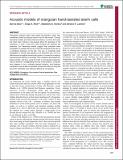Files in this item
Acoustic models of orangutan hand-assisted alarm calls
Item metadata
| dc.contributor.author | De Boer, Bart | |
| dc.contributor.author | Wich, Serge A. | |
| dc.contributor.author | Hardus, Madeleine E. | |
| dc.contributor.author | Lameira, Adriano R. | |
| dc.date.accessioned | 2018-01-10T13:30:19Z | |
| dc.date.available | 2018-01-10T13:30:19Z | |
| dc.date.issued | 2015-03-18 | |
| dc.identifier.citation | De Boer , B , Wich , S A , Hardus , M E & Lameira , A R 2015 , ' Acoustic models of orangutan hand-assisted alarm calls ' , Journal of Experimental Biology , vol. 218 , no. 6 , pp. 907-914 . https://doi.org/10.1242/jeb.110577 | en |
| dc.identifier.issn | 0022-0949 | |
| dc.identifier.other | PURE: 252019127 | |
| dc.identifier.other | PURE UUID: ea0944c7-10dc-44b1-9618-b0a44273ff7c | |
| dc.identifier.other | Scopus: 84964260982 | |
| dc.identifier.other | PubMed: 25788727 | |
| dc.identifier.uri | https://hdl.handle.net/10023/12453 | |
| dc.description | B.d.B. was funded by the European research council starting grant ABACUS project and the Innoviris ‘Brains back to Brussels’ programme. S.A.W. was funded by the Netherlands Organisation for Scientific Research NWO. A.R.L. was funded by the Menken Funds (University of Amsterdam). | en |
| dc.description.abstract | Orangutans produce alarm calls called kiss-squeaks, which they sometimes modify by putting a hand in front of their mouth. Through theoretical models and observational evidence, we show that using the hand when making a kiss-squeak alters the acoustics of the production in such a way that more formants per kilohertz are produced. Our theoretical models suggest that cylindrical wave propagation is created with the use of the hand and face as they act as a cylindrical extension of the lips. The use of cylindrical wave propagation in animal calls appears to be extremely rare, but is an effective way to lengthen the acoustic system; it causes the number of resonances per kilohertz to increase. This increase is associated with larger animals, and thus using the hand in kiss-squeak production may be effective in exaggerating the size of the producer. Using the hand appears to be a culturally learned behavior, and therefore orangutans may be able to associate the acoustic effect of using the hand with potentially more effective deterrence of predators. | |
| dc.format.extent | 8 | |
| dc.language.iso | eng | |
| dc.relation.ispartof | Journal of Experimental Biology | en |
| dc.rights | © 2015 The Author(s). Published by The Company of Biologists Ltd. This work is made available online in accordance with the publisher’s policies. This is the final published version of the work, which was originally published at: https://doi.org/10.1242/jeb.110577 | en |
| dc.subject | Deception | en |
| dc.subject | Kiss-squeak | en |
| dc.subject | Orangutan | en |
| dc.subject | Size exaggeration | en |
| dc.subject | Sound production | en |
| dc.subject | QL Zoology | en |
| dc.subject | Medicine(all) | en |
| dc.subject | Physiology | en |
| dc.subject | Ecology, Evolution, Behavior and Systematics | en |
| dc.subject | Aquatic Science | en |
| dc.subject | Molecular Biology | en |
| dc.subject | Animal Science and Zoology | en |
| dc.subject | Insect Science | en |
| dc.subject | NDAS | en |
| dc.subject.lcc | QL | en |
| dc.title | Acoustic models of orangutan hand-assisted alarm calls | en |
| dc.type | Journal article | en |
| dc.description.version | Publisher PDF | en |
| dc.contributor.institution | University of St Andrews. School of Psychology and Neuroscience | en |
| dc.contributor.institution | University of St Andrews. Centre for Social Learning & Cognitive Evolution | en |
| dc.identifier.doi | https://doi.org/10.1242/jeb.110577 | |
| dc.description.status | Peer reviewed | en |
This item appears in the following Collection(s)
Items in the St Andrews Research Repository are protected by copyright, with all rights reserved, unless otherwise indicated.

